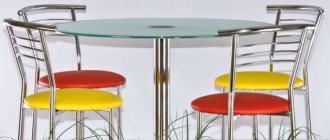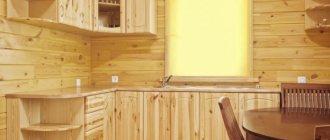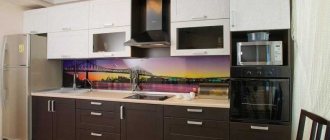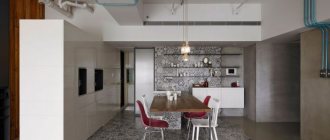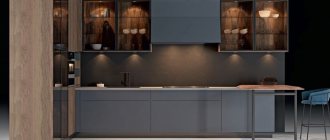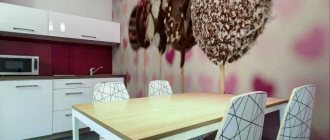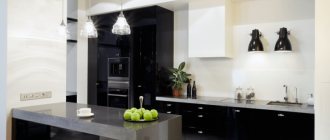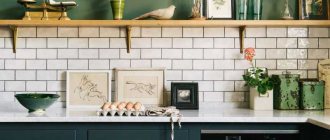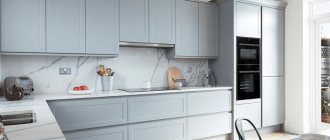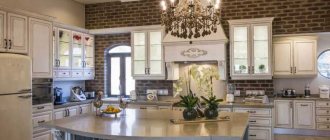Today we’ll talk about how to design a kitchen on your own. Kitchen design is one of the very first and most important stages of a kitchen renovation project.
So, you have made the decision to carry out a large-scale kitchen renovation, the budget has been approved, it’s time to sort everything out, so to speak, into pieces, decide on the future interior and the arrangement of interior elements in the kitchen.
In this difficult, but very exciting mission, there are 2 options for development: either we turn to specialists who will offer 2-3 kitchen layout options in a matter of minutes, or we roll up our sleeves and try to design the design ourselves.
First, let's consider the option of designing a kitchen yourself: the main stages, features and design tools.
Layout.
In the preliminary sketch we need to place the main kitchen appliances: refrigerator, stove, sink, work area. Why do we start with them?
Because all these elements of the kitchen are a little dependent: the sink - on the location of communications in the kitchen; stove - from a gas pipe and hood; The refrigerator must be kept at a distance from heat sources.
What is an apron and why is it needed?
The apron or hob is the distance from the top edge of the countertop to the bottom edge of the set. It absorbs splashes when cooking.
Naturally, the apron should be easy to clean, but it is very important that it has an attractive appearance. Based on this, let’s look at what you can use to make an apron in the kitchen.
Note!
DIY kitchen: step-by-step instructions, selection of furniture + rules for installing the kitchen
- Kitchen with gas stove: design features, photos of the finished renovation
Assembling a kitchen - step-by-step DIY assembly guide, necessary materials and tools
Choosing the type of kitchen.
In most cases, when dealing with small kitchens, the choice will fall on a straight or corner design.
We arrange the furniture either in a row along a long wall, or along two walls, actively using the corner of the kitchen.
Less often, when the dimensions of the kitchen allow you to expand, kitchen furniture can be placed along the contour of the kitchen (U-shaped kitchen) or you can choose the option with an island/peninsula, placing a work area, a bar counter or a dining table in the center.
Deciding on a style
It’s easy to get lost in the variety of styles, because there are hundreds of them. Such a rich “assortment” is due to the presence of a large number of “branches” within one direction. They obey general laws and adhere to the same rules, but have characteristic features that make it possible to distinguish these “child” styles into subgroups. Let us note five areas that are currently enjoying unprecedented popularity:
- Classical. “Long-liver” among styles. Classic is suitable for people with impeccable aesthetic taste, who love to surround themselves with luxury and feel “at home” in such an environment. The style is characterized by the use of pastel shades and tones from a rich brown range. Natural heavy fabrics are used in textiles, and wood and glass are used in decoration. The classic loves stucco, crystal, ornaments, complex patterns and smooth lines. In such interiors, not only decoration, but also the finishing itself becomes an art.
- Loft. The trend is relevant for a studio kitchen, since the industrial style was born in free spaces that were previously used for non-living purposes. Lofts are characterized by combinations of rough finishes and elegant details, an abundance of artificial lighting, and open communication systems. The prevailing materials are brick, stone, wood, and plastic.
- Provence. Noble rustic style with a touch of refined French flair. Aged furniture (antiques), light shades, a lot of white, floral patterns, indoor plants, wood decoration - these are the main features of the style.
- Minimalism. The direction is aimed at people who do not tolerate unnecessary things in their home. As a rule, white color prevails in the interior, only the necessary minimum of furniture is used, and a series of paintings on an accent wall is allowed as decor. The style is enlivened by unusual shapes and contrasts in the textures of finishing surfaces and furnishings.
- High tech. High-tech style that keeps up with the times. An abundance of household appliances, chrome surfaces, plastic and glass, a play of contrasts, the dominance of gray, black and white in the color scheme - this is the “minimum” program for “combed” constructivism.
In addition to the above trends, art deco, country, shabby chic, art nouveau, retro, futurism, neoclassicism, fusion, abstract art, Scandinavian and eco style are relevant.
We arrange furniture and appliances.
Let's move directly to the design stage. You should start with the bottom row of cabinets, in which we immediately place a sink, stove and refrigerator.
If necessary, we additionally mark on the plan the positions for the washing machine and dishwasher.
There are some restrictions in terms of placement of these elements, and it is advisable to comply with these restrictions:
- It is advisable to place the sink and dishwasher in close proximity to communications.
- In the case of a corner kitchen, do not try to place the sink in the very corner - this is not always convenient. But using a corner of the kitchen for a stationary water purifier, microwave and storage for kitchen electrical assistants is a more rational option.
- The stove/hob/oven depends on a gas pipe, socket, and kitchen hood. Naturally, no one has canceled the gas hose and electric extension cord, but the overall ease of use of the kitchen and the aesthetic appearance will lose from this.
- The sink, stove and kitchen work area are usually located in one line. In this case, it is desirable that the work area serve as a neutral zone between the sink and the stove. This arrangement has been tested for years and is very convenient.
- The refrigerator has heat protection, but it is better not to use it. In addition to the fact that the refrigerator should be located in a convenient place, contact with the radiator, stove and sunlight should be avoided if possible.
- Electricity. Calculate in advance the required number and location of sockets for electrical appliances. You don't have to stick to the existing wiring, but it's better to plan ahead and retrofit outlets so that they are always and easily accessible.
Having dealt with the lower tier, you can move on to the upper row of cabinets.
You should immediately take into account that the width of the upper tier should not be greater than the lower one, otherwise the ergonomics of the kitchen may be disrupted and injuries are possible.
Traditionally, the depth of the top row is 30 cm, the bottom row is 60 cm . An important element here is the hood.
The fireplace hood option involves a separate block instead of a cabinet, but a built-in hood will allow you to leave the top line of cabinets unbroken, with one condition that the cabinet above the hood will be one step smaller than the rest.
If pull-out cabinets become more convenient in the lower row, then the doors of the upper furniture row, as a rule, open horizontally or vertically using special lifts (cabinets 35 cm high).
Kitchen set assembly
So, when all the parts of the headset are made, you can start assembling. Well, how to make a beautiful kitchen without tools or fittings? They must be prepared in advance. Assembly is carried out in the following sequence:
- The lower tier is being installed.
- Wall cabinets are assembled from blanks.
- The table top is being installed.
- The sink crashes in.
After successfully completing the assembly of the kitchen set, you will become a master in this matter and the question of how to make a kitchen yourself will no longer be relevant for you.
Choice of color, material, texture.
Only after putting everything in its place can you begin to choose the material, texture and color of the facades, countertops, taking into account the chosen design.
- Color design. In general, the choice of color for furniture, decorative elements and appliances depends on the chosen style of interior design and the natural light in the kitchen.
- But no matter what design is chosen, it should be remembered that a moderate color scheme and the absence of bright toxic shades are the companions of kitchen comfort and a relaxing atmosphere. Contrast and accents can be created through stylish accessories.
- Lighting affects the usability of the kitchen. Central lighting is often not enough. In the main project, try to plan an additional light source in the sink area and sconces near the dining area, which will help achieve complete light harmony in the kitchen. But you also need to know the limits - no more than three large light sources in the kitchen.
Now let’s answer the question “Who should I turn to for help when designing a kitchen?”
It’s all very simple: if personal projects do not excite you, or the size and features of the kitchen do not allow you to come up with a solution yourself, we call one of two assistants for help.
Ceramic tile
The traditional version of a kitchen apron in our country. Currently, trade offers a wide range of ceramic tiles, so choosing the desired design is not a problem. However, this material has significant disadvantages for an apron.
- Over time, the seams lose their presentable appearance, since grease, dust and soot constantly get there, from which it is almost impossible to clean them. They are also an excellent environment for bacteria, which is generally unacceptable in the kitchen.
- Laying tiles requires careful preparation of the surface; it must be perfectly leveled, which can only be done by a professional, and this is an additional expense.
These two noted disadvantages may be a sufficient reason to think about how to make a backsplash in the kitchen other than tiles. Luckily there is a wide choice.
Designer.
Any furniture showroom will welcome you with open arms and assign a professional designer to provide advice and develop a kitchen project.
Don't forget to take with you a sheet of paper with your measurements taken in advance.
After the preliminary design has been approved, a surveyor will most likely be sent to your home to more accurately measure the kitchen and detect hidden pitfalls.
Design project with redevelopment
A redevelopment project is essentially not much different from an ordinary “sketch”. The only thing that needs to be taken into account is the dismantling of walls or their individual parts. On the plan, these places may be beautifully marked as free, but in reality their absence can lead to catastrophic consequences. Before you demolish something yourself, you need to prepare a project for future work. It is first given to architects, who make adjustments and approve the finished plan. Then you will have to go through a number of other authorities (fire department, sanitary service and management company). You will also need a package of documents to present to various authorities. All this redevelopment “whirlwind” can drag on for a long time. Be patient and take time. Typically, combined projects involve kitchens, living rooms and dining rooms. In the interior, it is worth taking into account not only the features of the new space, but also the zoning of the room, without which the picture will not look complete.
Specialists from design bureaus can provide free consultation on redevelopment issues online. They are also contacted for professional help when drawing up a project.
Drawing a drawing
Start the drawing with a schematic sketch. Square kitchens are quite rare, so you will most likely have to get creative with rooms of complex shapes and turn their disadvantages into advantages. Now transfer the layout onto a sheet of paper, indicate with dashes the locations of windows and doors. Typical kitchenettes in Khrushchev-era buildings, as a rule, have one opening for natural light, which can go out onto the balcony. If the room is small, then perhaps you should think about tearing down the partition and combining the two spaces. In two-room apartments and studios, this disadvantage is solved by combining it with the adjacent room (zone). For owners of country houses, the task is greatly simplified, since in this case the kitchens are usually spacious and can accommodate not only the necessary “stuffing”, but also a dining area designed for large companies. Then “imaginary” furniture is placed on the drawing of the room. They start with the furniture, then the dining area for the kitchen-dining room, marking the location of accent areas and decor. The decoration of the room will be “polished” in the process. At this stage, only a conditional picture is enough. If the decoration of the rooms is complex using frame structures, then these nuances are also displayed in the drawing.
Everything is at hand
Everything you might need while working in the kitchen: food, dishes, oven mitts, spices, cutting boards should be within reach so that you are not distracted by searching. Drawers near the desktop will do an excellent job of storing necessary things. A very convenient thing is a bottle holder: it takes up minimal space (25–30 cm), but you will be provided with a comfortable arrangement of spices, oil and other tall items that should be at hand during the cooking process.
Aesthetic enjoyment
For a kitchen to rightly be called the kitchen of your dreams, being in it should bring you pleasure, and not leave you indifferent. Therefore, when choosing a color scheme, focus on those shades that will evoke only positive emotions. Don't forget about the cute little things. If you love house plants, in any kitchen, even the smallest one, you can find room for at least one or two. They will not only enliven the interior, but will also purify the air.

